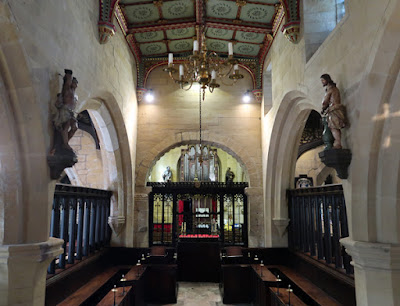 |
| A view west along the chancel |
During August 2022, I had made the most of the fine weather to further explore the geology of South Yorkshire, in Sheffield, Rotherham and Barnsley but, following on from my brief walk along the Rivelin Valley, I continued with my investigation of the mediaeval churches that I could reach by public transport from Treeton.
On my list of potential places to visit in 2023, of the 35 churches that I could theoretically get to, all but one would involve a bus journey to Sheffield, a train to either Barnsley, Doncaster, Wakefield and Leeds and then another bus to a relatively remote location, where buses run no more than hourly – with this being the situation at St. Wilfrid’s church in Hickleton.
It is 18 kilometres from Treeton to Hickleton as the crow flies, with the journey only taking approximately 27 minutes by car. Travelling by public transport, however, via either Barnsley or Doncaster, the distance travelled is approximately 52 km. To arrive at 11:00 am, the time I had arranged with Father Schaefer for the church to be opened, I set off from Treeton at 8:19 but, due to the timing of the X19 bus to Hickleton, I had to be in Barnsley for nearly an hour - much of which was spent wandering around the new Fountain Square and Glass Works.
Arriving at St. Wilfrid’s church, I introduced myself to Father Schaefer and immediately set about photographing its interior, starting with its short nave and C12 chancel arch - the oldest part of the church. When approaching the church, I had noticed that the dolomitic limestone is quite yellow in colour, which is exaggerated by the artificial lighting in the interior.
Pevsner describes the church as essentially Perpendicular Gothic, a style that dates from approximately 1350 to 1530, with the church guide stating that the principal phases of building were from the mid C14 and continuing into the C15; however, the Historic England description dates the north aisle as mid C16, with the single arch on the south side of the nave as early C16.
On the very very few occasions that a church has been specifically opened for me, unless the keyholder has a task to undertake, I have spent much less time looking around the interior than I would if left to my own devices with the guidebook. As such, I only had a very quick wander around to take a set of general record photographs of the principal architectural elements.
Except for some unusual imposts, which may be a characteristic of the late Perpendicular Gothic style, I didn’t notice any details in the masonry and was more interested in the fact that the church is elaborately decorated with statues, stations of the cross and other details that are very typical of churches with an Anglo-Catholic heritage.
This is the first mediaeval Anglo-Catholic church that I had encountered and these very elaborate and colourful decorative features form a very striking aspect of this church. My knowledge of the subject matter is extremely limited, but I had always thought that the Roman Catholic church and icons of popery had been swept away by the later Tudor monarchs and by the Puritan Oliver Cromwell and his associates, during the English Civil War.
Except for the Norman chancel arch, the only other feature of the church that dates back to this period or earlier is the circular font, which is described by Pevsner as having a frieze of four-petalled flowers and the church guide states is either Saxon or early Norman.









No comments:
Post a Comment